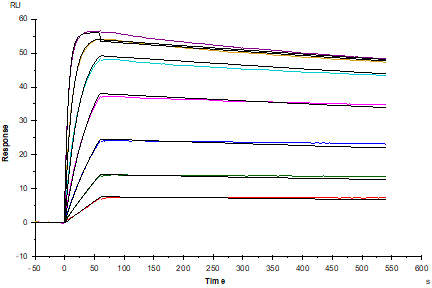PD-L1 Recombinant Rat mAb, F(ab')₂ Fragment (SDT-R072)
PD-L1,CD274,B7-H,B7-H1,B7H1,PDCD1LG1,PDL1,PDCD1L1,CD27L receptor,T-cell activation antigen CD27,T14,Tumor necrosis factor receptor superfamily member 7,PDCD1 ligand 1,Programmed death ligand 1,hPD-L1,N/A
货号: S0B0103
- 价格: ¥600
- 规格:
- 数量:
产品介绍 评论(0)
宿主来源
Rat抗原名称
PD-L1, F(AB')₂ FRAGMENT分子别名
N/A免疫原
N/A细胞定位
MembraneAccession
Q9EP73克隆号
SDT-R072抗体类型
Recombinant mAb抗体同种型
IgG2b应用
SPR反应种属 ?
Ms纯化方式
Protein G浓度
N/A标签
N/A性状
Liquid缓冲体系
PBS pH7.4储存条件
12 months from date of receipt / reconstitution, 2 to 8 °C as supplied
| 应用 | 稀释度 |
|---|---|
| SPR | 125nM-1.95nM |
Programmed death-ligand 1 (PD-L1) also known as cluster of differentiation 274 (CD274) or B7 homolog 1 (B7-H1) is a protein that in humans is encoded by the CD274 gene. Programmed death-ligand 1 (PD-L1) is a 40kDa type 1 transmembrane protein that has been speculated to play a major role in suppressing the adaptive arm of immune systems during particular events such as pregnancy, tissue allografts, autoimmune disease and other disease states such as hepatitis. The binding of PD-L1 to the inhibitory checkpoint molecule PD-1 transmits an inhibitory signal based on interaction with phosphatases (SHP-1 or SHP-2) via Immunoreceptor Tyrosine-Based Switch Motif (ITSM). This reduces the proliferation of antigen-specific T-cells in lymph nodes, while simultaneously reducing apoptosis in regulatory T cells (anti-inflammatory, suppressive T cells) - further mediated by a lower regulation of the gene Bcl-2. Upregulation of PD-L1 on immune cells (especially myeloid cells) can also lead to formation of an immunosuppressive environment in a highly localized manner that also allow the cancer cells to proliferate.
验证数据

Anti-His antibody Immobilized on CM5 Chip captured PD-L1/B7-H1 His Tag, Mouse, can bind PD-L1 Recombinant Rat mAb, F(ab')₂ Fragment (SDT-R072) with an affinity constant of 0.1826 nM as determined in SPR assay.






评论(0)